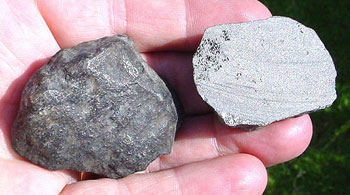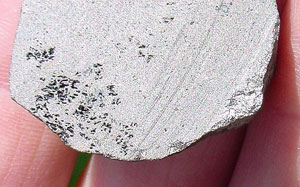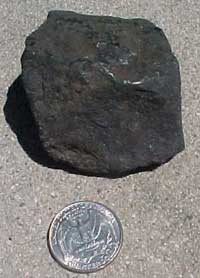ferromanganese
Robert Verish writes:
I would like to take this opportunity to personally thank Troy Bell, for his efforts in trying to determine the origin of a particular type of meteor-wrong that is commonly seen on eBay. Troy found his first specimen in the gravel of a parking lot near where he lives in Texas. When Troy told me that the gravel was a typical "slag", I told him to try and find more of this LBR (Little Black Rock) and to take some samples of the slag gravel. He found 2 more "little black rocks", which he sent to me, along with samples of the slag gravel.
My examination confirmed that the LBRs and the slag have a common origin. In addition, these LBRs are made from the same material that I have encountered numerous times from people wanting their "meteorites" identified. And I'm sure many on this List have encountered this, as well. Lately, a third of the meteor-wrongs that I have encountered are of this "sulfide-rich" material. Although there appears to be various sources for this material, I have always contended that this was waste material from an ore smelting process [slag]. But now, Troy's observant eye has found the "smoking gun" evidence that confirms that this material is a slag.
This confirmation also raises the concern that some of these LBRs could have elevated concentrations of arsenic and lead.
The following images show a cut surface of this material. Because of the above concern, BE ADVISED - to never DRY cut or grind this material, and to treat the cuttings and coolant with caution.
Image #1:

The interior "looks like" a natural sulfide mineral with a highly specular, metallic luster. But it is not a metal. Mostly crystalline with needle-shaped laths (an atypical crystal habit for sulfides). The exterior has a patina. Having been exposed to the forces of weathering, and over time, the sulfide-rich rock has formed a black tarnish.
Image #2: (click to enlarge)

Close-up of the cut surface. Locally vesicular; cavities will show cleavage for these synthetic (man-made) crystals. There are some inclusions of melted silicates.
As mentioned earlier, this kind of meteor-wrong has long been seen on eBay, but typically being auctioned as "Arizona ?? Meteorite"!!
Now that it has been identified, my curiosity about this material has been satisfied, and I will now move on to the next "mystery rock" (hopefully, it will be a real meteorite;-). But in the meanwhile, it may prove beneficial (since this stuff is so widespread) to have this "identified" material on a meteor-wrong web page in order to educate future meteor-wrong sellers.
Bob V.
I would like to take this opportunity to personally thank Troy Bell, for his efforts in trying to determine the origin of a particular type of meteor-wrong that is commonly seen on eBay. Troy found his first specimen in the gravel of a parking lot near where he lives in Texas. When Troy told me that the gravel was a typical "slag", I told him to try and find more of this LBR (Little Black Rock) and to take some samples of the slag gravel. He found 2 more "little black rocks", which he sent to me, along with samples of the slag gravel.
My examination confirmed that the LBRs and the slag have a common origin. In addition, these LBRs are made from the same material that I have encountered numerous times from people wanting their "meteorites" identified. And I'm sure many on this List have encountered this, as well. Lately, a third of the meteor-wrongs that I have encountered are of this "sulfide-rich" material. Although there appears to be various sources for this material, I have always contended that this was waste material from an ore smelting process [slag]. But now, Troy's observant eye has found the "smoking gun" evidence that confirms that this material is a slag.
This confirmation also raises the concern that some of these LBRs could have elevated concentrations of arsenic and lead.
The following images show a cut surface of this material. Because of the above concern, BE ADVISED - to never DRY cut or grind this material, and to treat the cuttings and coolant with caution.
Image #1:

The interior "looks like" a natural sulfide mineral with a highly specular, metallic luster. But it is not a metal. Mostly crystalline with needle-shaped laths (an atypical crystal habit for sulfides). The exterior has a patina. Having been exposed to the forces of weathering, and over time, the sulfide-rich rock has formed a black tarnish.
Image #2: (click to enlarge)

Close-up of the cut surface. Locally vesicular; cavities will show cleavage for these synthetic (man-made) crystals. There are some inclusions of melted silicates.
As mentioned earlier, this kind of meteor-wrong has long been seen on eBay, but typically being auctioned as "Arizona ?? Meteorite"!!
Now that it has been identified, my curiosity about this material has been satisfied, and I will now move on to the next "mystery rock" (hopefully, it will be a real meteorite;-). But in the meanwhile, it may prove beneficial (since this stuff is so widespread) to have this "identified" material on a meteor-wrong web page in order to educate future meteor-wrong sellers.
Bob V.
|
ferromanganese is sold as a suspect meteorite on eBay |
Bob publishes article (2007) Slag Meteor-wrongs in Meteorite Times Magazine
UPDATE - See Bob's - 2009 Article
Also see MWNews : Rock baffles experts
eBay seller
Dean Bessey's Odd Rock
Cascadia Meteorite Lab meteor wrong



